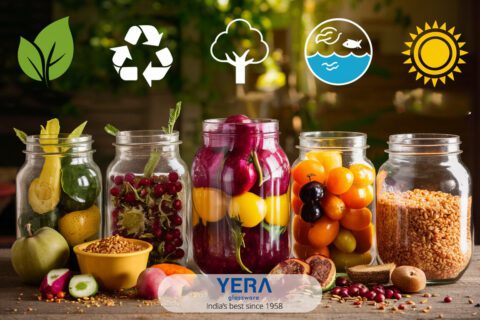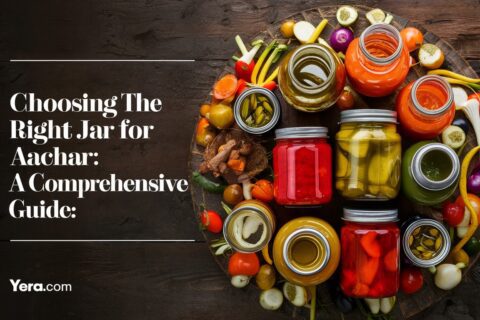Be it last night’s leftover pizza or some fresh broccoli stems to make soup…your refrigerator keeps everything fresh for you. But it has its limitations.
You need to ace your storage game to with kitchen storage jars to keep your leftovers and veggies fresh, increase their shelf live, and maintain the same taste over time.
Let us see 6 effective storage tips to do so:
Select The Appropriate Kitchen Storage Jar’s Size
It’s crucial to pick the proper measurement container when storing food in the refrigerator.
Finding a glass container that perfectly suits your requirements is simple because they are available in a variety of sizes.
There is a glass container that is ideal for the task, whether you’re storing leftovers, prepping dinners ahead of time, or maintaining the freshness of snacks.
Utilize Good Quality Glass Kitchen Storage Jars
Glass is strong – Compared to their plastic counterparts, glass products have a much extended lifespan and are more durable.
Additionally, this strength enables cooks all over the world to keep their food fresher for longer.
- Low likelihood of contamination – Glass goods are less likely to amalgamate or become contaminated with chemicals due to the nature of their formation. Consequently, it automatically becomes a favored product for food storage.
- Preserve Flavor– Glass containers have a robust, long-lasting construction. Glass containers can be used to keep food items’ flavor, taste, and aroma thanks to this dynamic behavior set.
- Cost-Effective – Compared to other products of a similar nature, glass tumblers or containers that can be used to store food and beverages typically tend to last much longer. Each item bought is therefore in a sense a long-term investment, which makes the purchase inherently cost-effective.
– 5000 years of tradition and practice go into the use of glass products. It is a product that has endured through generations and outperformed similar goods for more than 5000 years, making it even more reliable to be chosen over other packaging materials.
Mind The Meats
These should be kept in the coldest part of your refrigerator, which is frequently but not always at the bottom, preferably in their own drawer. Set the temperature of the meat compartment in your refrigerator to 29° F if you can.
Re-wrapping raises the likelihood that the food will be exposed to dangerous bacteria, so keep all fresh meat, fish, and poultry in their original store packaging.
Put a plate underneath the item if it didn’t come in a Styrofoam tray to collect any spills.
How To Store Garlic And Onions
These should be kept in the coldest part of your refrigerator, which is frequently but not always at the bottom, preferably in their own drawer. Set the temperature of the meat compartment in your refrigerator to 29° F if you can.
Re-wrapping raises the likelihood that the food will be exposed to dangerous bacteria, so keep all fresh meat, fish, and poultry in their original store packaging.
Put a plate underneath the item if it didn’t come in a Styrofoam tray to collect any spills.
Care For Your Veggies:
The safest and most convenient option for storing food in the refrigerator is glass containers. High borosilicate glass food storage containers are ideal for preserving the freshness of your food and keeping it secure for consumption.
So the next time you need a way to keep food in the fridge, think about using Yera food storage containers, which are made of borosilicate glass and can endure very low temperatures.
The majority of veggies, including celery, carrots, potatoes, broccoli, and cabbage should be kept in the crisper of your refrigerator in a plastic bag or container.
The easiest way to store mushrooms is in a paper bag. Fruit and vegetables should be kept separate in the refrigerator. They won’t mature too quickly as a result.
A quick and simple method to preserve nutrients and enjoy the flavor of summer vegetables all year is to freeze vegetables at home.
Before being frozen, most veggies need to be blanched. This means that after boiling the vegetable, whole or cut up, for 1-2 minutes, you should instantly plunge it into a bowl of ice water to stop the cooking.
This will prevent freezer burn on your veggies. Frozen vegetables can keep for up to a year without going bad.
Know About Your Fridge’s Humidity
A quick and simple method to preserve nutrients and enjoy the flavor of summer vegetables all year is to freeze vegetables at home.
Before being frozen, most veggies need to be blanched. This means that after boiling the vegetable, whole or cut up, for 1-2 minutes, you should instantly plunge it into a bowl of ice water to stop the cooking.
This will prevent freezer burn on your veggies. Its okay to have vegetables that are frozen less than a year.
Conclusion
The safest and most convenient option for storing food in the refrigerator is glass containers. High borosilicate glass food storage containers are ideal for preserving the freshness of your food and keeping it secure for consumption.
Therefore, the next time you need to store food in the refrigerator, think about using All glass containers, which are made of borosilicate glass and can endure very low temperatures.













